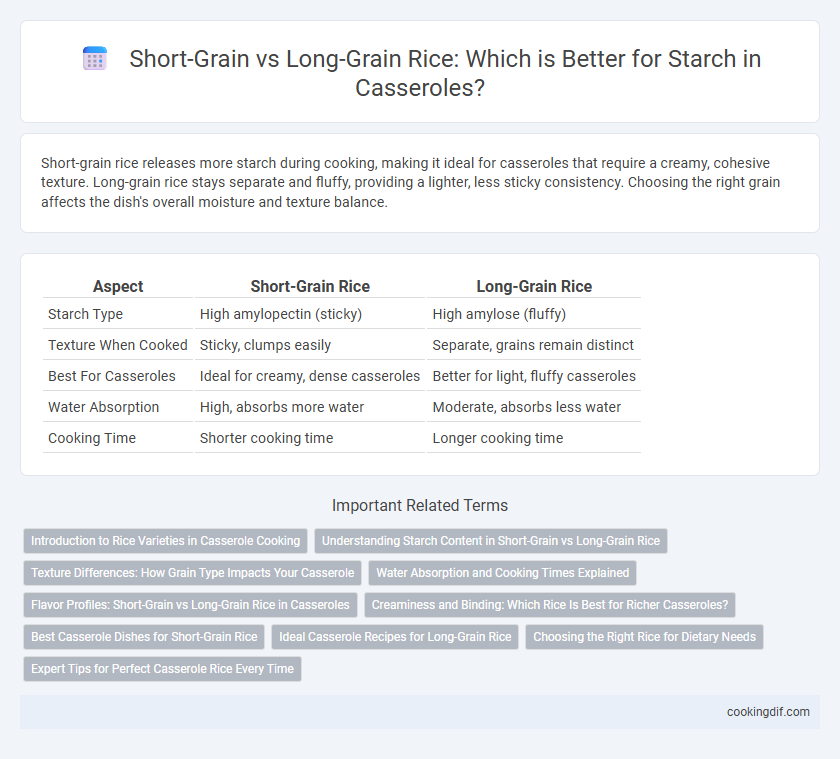Short-grain rice releases more starch during cooking, making it ideal for casseroles that require a creamy, cohesive texture. Long-grain rice stays separate and fluffy, providing a lighter, less sticky consistency. Choosing the right grain affects the dish's overall moisture and texture balance.
Table of Comparison
| Aspect | Short-Grain Rice | Long-Grain Rice |
|---|---|---|
| Starch Type | High amylopectin (sticky) | High amylose (fluffy) |
| Texture When Cooked | Sticky, clumps easily | Separate, grains remain distinct |
| Best For Casseroles | Ideal for creamy, dense casseroles | Better for light, fluffy casseroles |
| Water Absorption | High, absorbs more water | Moderate, absorbs less water |
| Cooking Time | Shorter cooking time | Longer cooking time |
Introduction to Rice Varieties in Casserole Cooking
Short-grain rice contains higher starch content, making it ideal for casseroles that require a creamy, cohesive texture. Long-grain rice has less starch, resulting in fluffy, separate grains that maintain structure during baking. Choosing the right rice variety affects moisture absorption and the overall consistency of casserole dishes.
Understanding Starch Content in Short-Grain vs Long-Grain Rice
Short-grain rice contains higher amylopectin levels, resulting in a stickier texture that binds well in casseroles, enhancing creaminess and structure. Long-grain rice has a higher amylose content, producing a fluffier, separate grain ideal for casseroles where distinct rice texture is preferred. Understanding these starch differences is crucial for achieving the desired consistency and cohesion in casserole dishes.
Texture Differences: How Grain Type Impacts Your Casserole
Short-grain rice contains higher amylopectin levels, resulting in a sticky, creamy texture ideal for casseroles requiring a cohesive, moist consistency. Long-grain rice has lower starch content, producing fluffy, separate grains that prevent clumping and maintain a drier texture in baked dishes. Choosing between short-grain and long-grain rice directly influences the casserole's overall mouthfeel and structural integrity.
Water Absorption and Cooking Times Explained
Short-grain rice contains higher amylopectin starch, resulting in greater water absorption and a stickier texture ideal for creamy casseroles. Long-grain rice, with more amylose starch, absorbs less water and maintains separate grains, making it suitable for casseroles requiring fluffy textures. Cooking times for short-grain rice typically range from 15 to 20 minutes, while long-grain rice often requires 18 to 25 minutes to fully absorb water and achieve optimal tenderness.
Flavor Profiles: Short-Grain vs Long-Grain Rice in Casseroles
Short-grain rice has a higher starch content, giving casseroles a creamy, sticky texture and a rich, slightly sweet flavor that enhances comfort dishes. Long-grain rice contains less starch, resulting in fluffy, separate grains with a mild, nutty taste that complements casseroles requiring distinct grain separation. Choosing between short-grain and long-grain rice directly influences the casserole's texture and flavor complexity, making the starch content a critical factor in recipe success.
Creaminess and Binding: Which Rice Is Best for Richer Casseroles?
Short-grain rice contains higher starch levels than long-grain rice, making it ideal for casseroles requiring creaminess and binding. Its natural stickiness enhances the texture, creating richer, more cohesive dishes. Long-grain rice remains separate and fluffy, better suited for lighter, less starchy casseroles.
Best Casserole Dishes for Short-Grain Rice
Short-grain rice contains higher starch content compared to long-grain rice, making it ideal for creamy and cohesive casserole dishes. Its sticky texture helps bind ingredients, creating a rich and satisfying consistency in recipes like cheesy rice casseroles and baked risottos. For best results, select short-grain varieties such as Arborio or sushi rice to enhance moisture retention and flavor infusion in casseroles.
Ideal Casserole Recipes for Long-Grain Rice
Long-grain rice contains less starch than short-grain rice, providing a fluffy and separate texture ideal for casseroles that require distinct grains and less creaminess. Its lower amylopectin content prevents clumping, making it perfect for recipes like chicken and vegetable casseroles where absorption of sauces without stickiness is key. Using long-grain rice enhances casserole dishes by maintaining structure and delivering a balanced mouthfeel.
Choosing the Right Rice for Dietary Needs
Short-grain rice has a higher starch content, making it ideal for creamy casserole dishes that require a sticky texture. Long-grain rice contains less starch and remains fluffy and separate when cooked, suitable for casseroles needing distinct grain separation. Choosing short-grain rice supports dietary needs focused on lower glycemic index, while long-grain rice benefits those seeking gluten-free, lighter texture meals.
Expert Tips for Perfect Casserole Rice Every Time
Short-grain rice contains higher amylopectin, making it stickier and ideal for creamy casseroles that require a cohesive texture. Long-grain rice holds more amylose, resulting in a fluffier, separate grain structure perfect for lighter casserole dishes. Expert tips recommend rinsing long-grain rice to reduce excess starch and using slightly less water with short-grain rice to prevent excessive stickiness for perfect casserole rice every time.
Short-grain rice vs long-grain rice for starch Infographic

 cookingdif.com
cookingdif.com